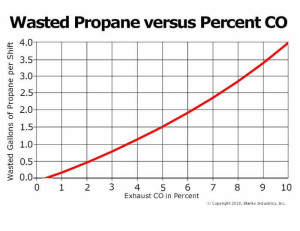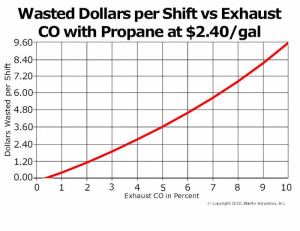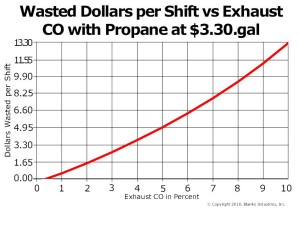Frequently Asked Questions for FAQs – Carbon Monoxide Analyzers
Industrial Lift Trucks | Motorcycle Tuning | OSHA Compliance | Lawnmowers
Frequently Asked Questions – Industrial Lift Trucks
Q. How much does a lift truck waste per day due to exhaust CO?
A. Carbon monoxide is evidence of wasted fuel. With perfect combustion, all the carbon in the fuel burns to carbon dioxide and all the hydrogen burns to water vapor. For less than perfect combustion, fuel loss rises rapidly. In lift trucks adjusted to run smoothly and not adjusted using a CO analyzer, the exhaust CO is usually between 3% and 10%. In our experience trucks with carbureted systems, more than half of them emit between 5% to 10% CO and 9 out of 10 are between 3% to 10% CO. Tier 1 trucks also fall into this population. About 25% of Tier 2 and Tier 3 trucks exhibit high CO due to tampering or lack of proper maintenance. The following three graphs demonstrate this waste in gallons/shift and dollars/day at two propane prices ($2.40/gallon & $3.30/gallon). Click on a graph to enlarge. |
 |
 |
Q. At what level of carbon monoxide do I set my carburetor?
A. Carburetor and fuel injector manufacturers recommend carbon monoxide levels be between 0.4 to 0.7% at idle and at full load. Blanke Industries recommends a level of 0.5% CO.Q. OSHA measures CO in parts per million, ppm. What is that in percent?
A. 10% CO is 100,000 ppm, 1% CO is 10,000 ppm, 0.5% CO is 5,000 ppm, 0.1% CO is 1,000 ppm and 0.01% CO 100 ppm.Q. How are fuel and carbon related to cap and trade?
A. Hydrocarbon based fuels are a mixture of carbon and hydrogen molecules bonded together. Propane is three carbon molecules and eight hydrogen molecules.- 8 gallons of propane weighs 33 pounds.
- 33 pounds of propane contains 27 pounds of carbon and 6 pounds of hydrogen.
Q. The manufacturer says we need a four or five gas analyzer. Are they right?
A. Manufacturers recommend multiple gases because that is how California requires them to report emissions. These laboratory grade gas analyzers are used in conjunction with dynamometers and report results in grams per horsepower hour and not in percent like the instruments you use. In order to maintain California’s emission certification, a small number of engines from the field are tested annually by the manufacturer. This insures their durability and their emissions stay within specifications throughout the useful life of the engine. Unless the manufacturer gives you pass/fail levels for carbon monoxide, hydrocarbons, carbon dioxide, oxygen and oxides of nitrogen, you have no ability to separate good engine performance from bad. You could own a very expensive analyzer and use only the CO channel. This is wasteful and complicates a tune-up. Blanke Industries approach is to recommend a four or five-gas analyzer in the main shop if the data is required to support warranty claims to the manufacturer. A single CO analyzer is all that is needed for all other shop and field related tune-ups. It is easier to use, faster, more rugged and does not require a technician to be schooled in the nuances of reading four or five gases, which are constantly changing under different engine conditions. In the heyday of auto emissions tune-ups, technicians took 40 hour courses to understand how to use all five gases to make an accurate diagnosis. This level of training is needed to keep from getting confused. And, remember OSHA. They regulate the indoor air and they impose hefty fines for high CO levels in the workplace. Keeping OSHA’s Industrial Hygienists satisfied at your customer’s locations will earn your company a lot more dollars than are available doing warranty work. In summary, use a four of five-gas analyzer in the shop if you have to for warranty work, and a single gas CO analyzer in your vans for all other emission testing and tune-ups.Q. My trucks are running well. Why do I need a CO analyzer?
A. If running well means smoothly and with power, your trucks may still be wasting fuel because their carburetors are set too rich. A fleet of ten trucks running on three shifts can easily waste $15,000 to $48,000 of propane per year. By setting CO at 0.5% at idle and full load, the engine still runs smoothly and with power while saving major fuel dollars.Q. What does OSHA use for industrial lift truck emissions testing?
A. The states of Connecticut, Michigan, Minnesota and Washington all use the Blanke Industries CO Series 2500. OSHA’s Cincinnati Technical Center also have CO Series 2500 analyzers available on loan to the Federal OSHA offices nationwide. OSHA uses two types of CO analyzers:- those that measure CO in parts per million in air and
- those that measure raw exhaust in percent.
Frequently Asked Questions – Motorcycle Tuning
Q. How can your CO analyzer help me?
A. It will help you in two ways. For a road hesitation or stumble, it will help you save time by showing you quickly if the pilot jet is too big or too small. Half the time you change one, you have gone the wrong way, meaning another test ride and another jet size is required. It will assist you in obtaining maximum power from all engines. An engine running too lean is leaving about 8% of it is available horsepower trapped because it is starving for fuel.Q. What should I see for CO from an engine?
A. New engines with the latest emission control levels will produce a CO level of about 0.5% in all operating modes including: idle, cruise and full throttle. They need to run very lean to pass EPA’s emission standards. However, at 3% CO in all modes of idle, maximum horsepower can be obtained. As stated above, this will be about an 8% gain over the EPA mandated levels.Q. Do I need a dynamometer to obtain maximum horsepower?
A. No, the dynamometer only indicates the horsepower. Most use a roll-on method of from 30 mph to 80 mph. With proper timing and the fuel system delivering enough fuel so CO is close to 3%, the engine is at maximum horsepower.Q. How do I set the fuel mix properly?
A. Blanke Industries recommends a road test where the problems can be found and the exhaust CO recorded. This record gives you a Flow Print of the carburetor showing fuel flow through various operating modes. If CO is low, the fuel system is too lean. If CO is high, the fuel system is too rich. With experience, you will be able to tell how far to go with jetting or with the new fuel controls used on fuel injected bikes.Frequently Asked Questions – Lawnmowers
Q. Why should we convert our commercial lawnmowers to propane?
A. The costs for fuel per running hour will be 30% to 40% lower due to propane costing much less than gasoline.Q. What is the energy level of propane per gallon versus a gallon of gasoline?
A. One gallon of propane has about 73% to 75% of the energy contained in a gallon of gasoline. It will take about 1.4 gallons of propane to run a commercial lawnmower as long a it would run on a gallon of gas.Q. Why is a carbon monoxide analyzer needed to setup and maintain commercial lawnmowers?
A. Carbon monoxide is an indicator of richness. Most engines, small and large, like to run rich. When rich, they emit 5% to 7% CO indicating a waste of about 20% to 30% of their fuel. They will still run well and start easily when CO is set to 0.5% at idle and 1.5% under full load. Without using a CO analyzer, the tune-up technician cannot insure the conversion to propane will actually save fuel dollars as there is no way to know how rich the engine is running.Q. Gasolines shows drips if leaking. How we know there is not a leak with propane?
A. Commercial propane has an oder mixed in it that can be smelled if there is a leak. Also. soapy water can be painted on any connections to see if any bubbles are being made.Q. Does my shop need to be certified to do these conversions?
A. We know of no state or locale requiring certification to install propane conversions onto lawnmowers. However, manufacturers of conversion kits recommend installing shops get trained in the nuances of propane and the installed devices. Hendrix Gastrux, Inc., of Wauconda, IL, a major kit manufacturer offers one and one and a half day seminars at the installers site. Cost is $1,000 and $1,500 respectively. Certification is primarily a marketing tool offered by the OEMs and kit manufacturers and not a local requirement.Frequently Asked Questions – OSHA
Q. How will OSHA measure the air in my building?
A. The inspector will usually start an inspection where he or she feels carbon monoxide will be the highest and do a simple spot check. If the level is above 50 PPM at this spot, the inspector will consider installing an 8 hour testing device which samples the air and establishes an average carbon monoxide level during that time.Q. What carbon monoxide level is acceptable?
A. The Federally accepted level is an average of 50 PPM over an 8 hour period. However, the Federal law permits the States to set even more stringent levels, usually 35 PPM. So you will need to check with your local OSHA branch to verify what is acceptable at your location.Q. Some OSHA inspectors stand behind an industrial lift truck and sniff with a PPM carbon monoxide analyzer. Is this an accurate technique?
A. No, the PPM analyzers usually measure up to 2,000 PPM carbon monoxide. At the tailpipe of a properly adjusted industrial truck the levels are 5,000 PPM. The analyzer cannot read high enough to get meaningful numbers. Also, any cross draft from air movement will blow the exhaust plume away from the analyzer. So, this approach in not only useless, but is dangerous as a high carbon monoxide emitter could appear to be running clean.Q. OSHA measurers in PPM, what is that in percent?
A. 10% is 100,000 PPM, 1% is 10,000 PPM, 0.5% is 5,000 PPM, 0.1% is 1000 PPM and 0.01% is 100 PPM.Q. Is the Blanke Industries Series 100 CO Tracker approved by OSHA?
A. OSHA does not approve, nor recommend carbon monoxide analyzers. Our analyzer measures with a similar sensor, performs spot checks and provides 8 hour average readings. The readings from the Blanke Industries CO Tracker will be very close to if not the same as an OSHA analyzer.Q. Has OSHA recently changed how it works with American industry?
A. Originally, OSHA was responsible for policing American Industry. Recently, OSHA has modified their approach and now helps businesses find solutions. The Consulting, Education and Training (CET) arm of OSHA will audit a facility, test and isolate poorly tuned industrial lift trucks. Information learned through this group will not be forwarded to the enforcement arm of OSHA unless the factory refuses to solve the problem the CET group locates. This is a valuable service and is currently under used by American industry.Q. What does OSHA use for industrial lift truck emissions testing?
A. The states of Connecticut, Michigan, Minnesota and Washington all use the Blanke Industries CO Series 2500. OSHA’s Cincinnati Technical Center also have CO Series 2500 analyzers available on loan to the Federal OSHA offices nationwide. OSHA uses two types of CO analyzers:- those that measure CO in parts per million in air and
- those that measure raw exhaust in percent.

